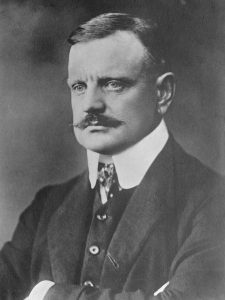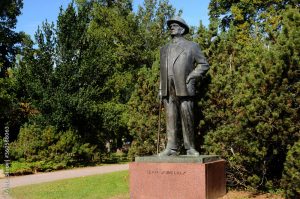Jean Sibelius (1865-1957)
“I do not think of a symphony only as music in this or that number of bars, but rather as an expression of a spiritual creed, a phase in one’s inner life”
“How little the public and the critics realize what I have given them…My time will come.”

Overview
Jean Sibelius was born on December 8th, 1865, in Hämeenlinna, a small town north of Helsinki. In 1875, at the age of 10, he wrote is first piece of music for violin and cello. In 1880, he started taking violin lessons. In the autumn of 1885, he moved to Helsinki to study law. He also enrolled in the Helsinki Music Institute (now called the Sibelius Academy). Sibelius soon abandoned his legal studies. His first masterpiece, the String Quartet in A minor, was performed for the first time on the 29th of May 1889.
During 1889-90, he studied in Berlin. In 1890-91 he studied in Vienna. He made a great impression in 1900 with his nationalistic tone poem Finlandia, a composition that has remained popular in concert halls to this day. The wonderful and popular Symphony No, 2, with its ecstatic climax, was composed in 1901 and 1902. In 1904, Sibelius moved with his family to Villa Ainola, the house that they had built in Järvenpää, some 40 km north of Helsinki.
The astonishingly beautiful Concerto for Violin was completed in 1904-05. He also composed the popular Valse Triste in 1904, and it was played all over Europe. With it, Sibelius’s name became even better known. If he had had a good publishing contract, he would have become a rich man, but he sold the rights of the piece for a petty sum.
With the completion of Tapiola in 1926, Sibelius’s composition came to an end. He lived for another 30 years but released no work of any stature. During the 1930s, there were some small works. However, by the end of the decade, he had stopped composing, except for a few minor arrangements.
Why was he silent? The story is not fully known, but during the 1930s, a strong torrent of reaction to Sibelius’s music grew in the USA and Europe. As the discordant music of Arnold Schönberg, and the ugly music of Igor Stravinsky became more accepted, they became the cultural heroes of classical music. As they rose, Sibelius fell. Criticism was leveled against the Finish composer, branded as a reactionary nationalist who wrote outdated music in archaic forms.
Sibelius composed seven symphonies. He worked on an eighth for many years, then — along with other works that we will never hear — destroyed it.

He passed away at Ainola on the evening of September 20th, 1957, at the same time as his Symphony No. 5 was being performed in the University of Helsinki hall. The central part of Sibelius’s work consists of his symphonies and other orchestral works, but he composed piano, chamber, choral, and incidental music, as well as an opera. Sibelius has become the national symbol of Finnish music and of even of Finland itself.
Sibelius
from “The Ostracism of the Tonal Composers” by Don Robertson (2005)
During the 20th Century, when what was called modern or contemporary music was officially launched by the infamous 1913 performances of Stravinsky’s Rite of Spring and Schönberg’s Chamber Symphony, composers writing in the more traditional “romantic” style of the 19th century began to suffer the consequences of being branded out-of-date, and this seriously limited the amount of positive music that was being written for the concert halls, now increasingly filled with discords and confusion.
Jean Sibelius was born in Finland in 1865. By the 1890s, he had made his mark as a composer of orchestral music, his En Saga being completed in 1892 and Karelia Suite the following year. His first symphony was finished in 1899 and his famous Violin Concerto (one of the greatest ever written) came five years later.
Sibelius composed in a thoroughly romantic style, with lush chords and melodies. His music was filled with passion, and therefore, as the concert world turned more and more to the “modernity” the current fashion (music infused with stress, discordant and disjointed rhythm) it became increasingly difficult for the music of Sibelius to be accepted.
The Vilification of Sibelius
University professors in the theory and composition classes of major universities began falling more and more into the footsteps provided by Austrian composer Arnold Schönberg, adopting his intellectual theories and punishing with abuse those students who wrote in “outdated” musical styles. Music critics and other well-known personalities were also lured into the dark force of “modern” music. Sibelius’s music was severely criticized, first by only a few critics, then finally by some of the most influential figures in European classical music.
The famous conductor René Leibowitz (1913-1972) called Sibelius the world’s worst composer. Nadia Boulanger, one of the most influential figures in 20th Century music, with whom most of the famous American twentieth century composers had studied (Elliot Carter, Aaron Copland, David Diamond, Cecil Effinger, Donald Erb, Irving Fine, Philip Glass, Andrew Imbrie, Roy Harris, Norman Lockwood, Daniel Pinkham, Elie Siegmeister, Walter Piston, and Virgil Thompson for starters) called Sibelius “a tragic case.”
This kind of criticism effected Sibelius deeply.
“I have had to suffer a good deal for having persevered in composing symphonies at a time when practically all composers turned to other forms of expression,” he said.
The Music Stops Here
Around mid-century, Sibelius stopped writing music altogether. By this time, he had become a laughingstock among the “Musical Elite.” However, in America his music had developed a wide popular appeal, a situation largely due to the fact that not only did the American public love his music, but he was tirelessly championed by Olin Downes, the music critic for the New York Times.
Sibelius was also loved by the public in England, where he was greeted favorably by the famous English critic and writer Ernest Newman, and in Germany, where he found public acceptance. Other central European countries, where Sibelius’s music wasn’t (and perhaps still isn’t) performed, wanted little to do with him, though, and critics in these countries scoffed at stories about those silly American and English concert attendees.
Downes had a difficult job in America promoting Sibelius’ music, however, as he was continually challenged by the machine called “The American Composers,” most of whom had studied with Boulanger. Among them was Aaron Copland, considered one of America’s elite composers by the musical establishment, who in his 1941 book called Our New Music, wrote:
“The nonsense about Sibelius was due to the exaggerated commentaries of a handful of English and American critics [referring to Newman and Downes, mostly] who obscured the true picture of a late-19th-century composer who had nothing significant to say for 20th-century ears… The attempt to set Sibelius up as a great modern composer is certain to fail.”
Copland was well off the mark on that one, as Sibelius continues to move his way up the ladder of those who really were the great composers of the 20th Century. Personally, I consider Sibelius to be one of the five greatest composers of that century (with Scriabin, Ropartz, Ives and Duruflé).
Sibelius had not adopted Schönberg’s atonality, nor had he mimicked Stravinsky’s disconnected rhythmic monstrosities, and therefore he was washed up as far as the music elite were concerned. Meanwhile, Copland was composing the most trivial of trinkets, such as his ballet Rodeo, for public consumption, side-by-side with his concession to modern music: more ‘serious’ works written in a discordant style, such as his Piano Concerto, and other compositions like Connotations, and Inscape… music that is practically unknown today, but guaranteed to keep his fellow ‘serious’ composers happy, ensuring that his “Great 20th-Century Composer” status remained alive. But can any work of Copland’s even come close to Sibelius’ Violin Concerto, or to his symphonies, works that have a spiritual potency that touches the soul?
Copland wasn’t alone, however. Another American composer, Virgil Thomson, began tearing into Sibelius publicly during 1940, when Thomson became the music critic for the New York Herald Tribune newspaper. His first printed review was a scathing attack on Sibelius and his second symphony. He branded Sibelius a “provincial composer beyond description” and derided his music’s popular appeal. Another composer, Russian composer Nicholas Nabokov, called Sibelius’s symphonies “antediluvian monstrosities.” Musicologist Paul Henry Lang, professor at Columbia University, author of the 1,107-page Music in Western Civilization and successor to Thomson at the Tribune, was astounded by the popularity of Sibelius’s music in America and wrote that the good points in the composer’s favor were offset by the “obesity…turgidity, and redundancy” in his music, where the melodies were too long and drawn out. Famous American critic Harold C. Schonberg, in his book The Lives of the Great Composers, labeled Sibelius “simply a minor composer.”
Music that expressed beauty and love such as Sibelius’ was an anachronism during the period of 20th-century “modernity,” and critics referred to it as being overly sentimental, boring, and bad.
Meanwhile, the American and English public preferred the music of Sibelius over that of the modern intellectuals such as Webern, Schönberg and Stravinsky, who are still to this day considered 20th century musical gods. There was such a negative acceptance of Sibelius’ music by those in charge that the extremely sensitive composer found it more and more difficult to create new works, so much so that he was unable to give his last 8th symphony to the world, destroying it instead.
- Symphony No. 2, composed in 1901-1902, performed by the NHK Symphony Orchestra, conducted by Paavo Järvi.
- Tapiola, composed in 1926, performed by the Finnish Radio Symphony Orchestra, conducted by Paavo Berglund. (1 hour)
Symphony No. 5, composed during 1915-1919, performed by the Chamber Orchestra of Europe, conducted by Paavo Berglund. Follow-along score. (30 minutes)
